SSZTCT4 april 2015 SM72295 , SM72442
As the reserves of non-renewable sources of energy (like coal, petrol and others) continue to deplete, there is an ever-increasing demand for “cleaner” sources of energy such as solar or wind energy. The future lies in the efficient conversion of these sources of renewable energy into electricity. In this post, I’ll present the hardware and software solutions needed for a future solar smart home with maximum power extraction from a panel through a maximum power point tracking (MPPT) algorithm.
Leveraging Texas Instruments’ system-level expertise in understanding the entire photovoltaic (PV) system – from panels to grid – combined with its industry-leading design, process, packing technology and solar IC solutions raise the IQ of renewable energy based systems and help maximize the return on investment (ROI) for end users. TI’s solar IC product portfolio includes solutions that help lower the cost of PV arrays by integrating the electronics that process power for distribution, condition signals for communication, increase safety of solar arrays, and help maintain maximum power from individual panels.
Solar IC solutions (renewable energy grade) and reference designs for various PV components including DC/DC power optimizers, DC/AC microinverters and inverters, MPPT-based battery charge controllers, PV safety solutions, and digital signal processor (DSP)- and ARM-based microcontrollers (MCUs) provide system control and support communication technologies needed for smart connected homes.
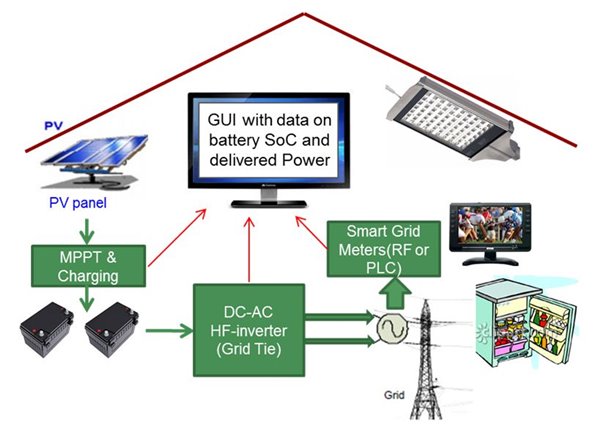 Figure 1 Smart Connected Home with
Renewable Power Storage
Figure 1 Smart Connected Home with
Renewable Power Storage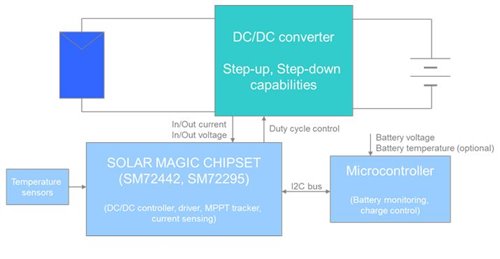 Figure 2 DC/DC MPPT Charger’s Block
Diagram
Figure 2 DC/DC MPPT Charger’s Block
DiagramMPPT chargers and optimizers like the SM72442/SM72245 MPPT digital controller and SM72295 PV full-bridge driver are designed to control high-efficiency DC/DC conversion used in PV applications and offer high integration. The SM72295 is a full-bridge metal-oxide semiconductor field-effect transistor (MOSFET) driver with 3A (a higher number of FETs in parallel for higher power) peak current drive capability, dual integrated current-sense amplifiers and integrated boost-strap diodes. The SM72245 may be useful for other designs, as it’s a programmable MPPT controller capable of controlling four pulse-width modulated (PWM) gate-drive signals for a four-switch buck-boost converter. The SM72245 also features a proprietary algorithm called panel mode (PM) that allows the panel to be connected directly to the output of the power-optimizer circuit when the input-to-output voltage ratio is close to one. This provides an opportunity to optimize the efficiency of the power optimizer when the load is naturally matching the maximum power point of the panel.
Grid Tie Inverter
Grid-tied solar-power solutions help meet the technical demands of the smart grid. They enable reactive power handling, necessary functions such as control of power stages, phase/frequency locking and MPPT. All of these combine to create more robust and efficient grid-tied solar-energy harvesting systems.
Performance MCUs such as TI’s C2000™ real-time control MCUs provide the high level of computational performance and programming flexibility needed for real-time signal processing in solar-power inverters. Highly integrated digital signal controllers help inverter manufacturers create more efficient, cost-effective and reliable products that can support the growing demand for solar energy.
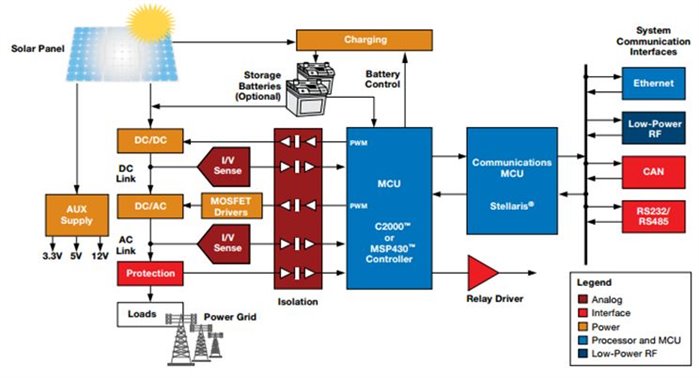 Figure 3 Grid Tie Inverter
Figure 3 Grid Tie Inverter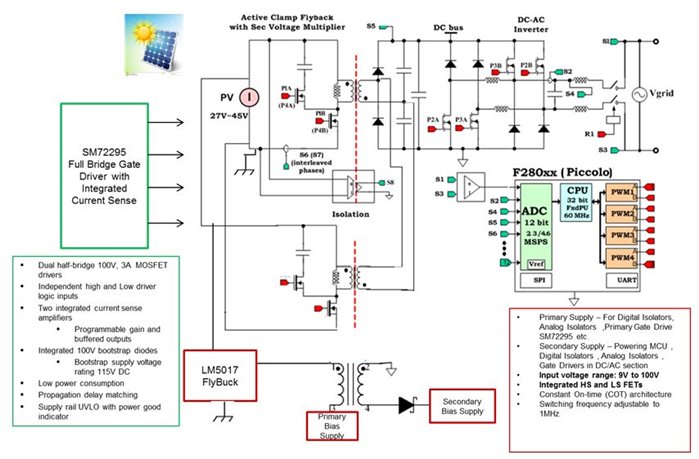 Figure 4 DC/DC Section of Grid Tie Microinverter
Figure 4 DC/DC Section of Grid Tie Microinverter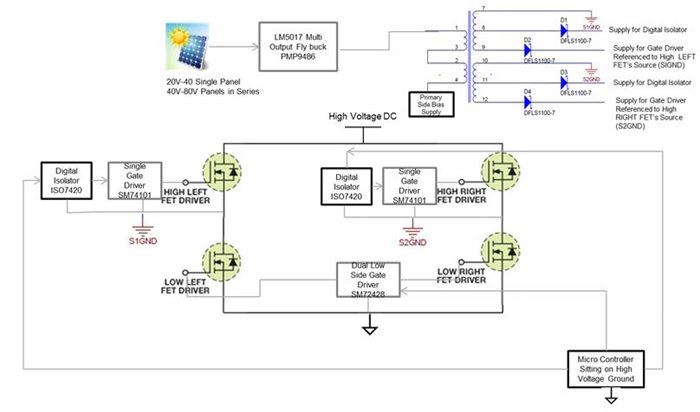 Figure 5 DC/AC Section of Grid Tie Microinverter
Figure 5 DC/AC Section of Grid Tie MicroinverterPulling It Together
Smart energy meter (also known as smart e-meter) requirements around the world are rapidly evolving in response to market forces and governmental regulations mandating smart grid deployments. Smart grid applications such as dynamic pricing, demand response, remote connect and disconnect, outage management, network security, and reduction of nontechnical losses are driving the need for increasing technological sophistication in today’s smart e-meter solutions.
A variety of communication options could be chosen, such as PLC, microwave, wireless, fiber, Ethernet, or Satellite. The applications include IEC61850 Gateway, Protocol Convertor, Serials Servers, Copper to Fiber Convertor, GPS Time Master, Data Concentrator, GSM/GPRS Modem, etc
Take a look at this power line communications (PLC) lite reference design for industrial applications to see an implementation for adding communications to industrial equipment such as solar arrays. This design offers higher data throughput than earlier forms of PLC and greater robustness for transmission across noisy electric lines by using orthogonal frequency-division multiplexing (OFDM) physical layer (PHY) technology.
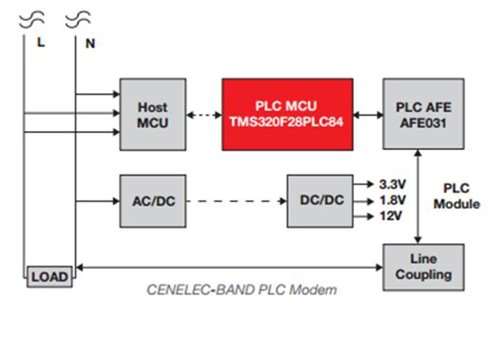 Figure 6 CENELEC-BAND PLC Modem
Figure 6 CENELEC-BAND PLC ModemOne of the key design challenges in Smart Grid design is the MPU selection, which should have enough peripherals to handle different communication interface, and advanced networking stack processing capability. The TI Sitara™ processor family enables developers to easily add multiple connectivity options including <1 GHz (LPRF), general packet radio service (GPRS), and multiple PLC standards. Furthermore, ICSS-PRU (Industrial Communication Sub-System – Programmable Real-time Unit) engine can perform very low latency data packet processing to meet IEC62439 Ethernet redundancy requirement, at the same time, the IEC61850 substation stack could be running on the Sitara™ processor core. It will bring BOM and power consumption optimized SOC solution for most of IEC61850 gateway applications
Solar harvesting requires efficient power solutions, reliable grid interconnections and high data volume and low latency communications .A diverse product portfolio is needed, that provides unique solutions for power density, intelligent, high voltage, and integrated system. And, with our efforts at Texas Instruments to pioneer and progress leading-edge innovations in circuit, packaging and device technologies, we have the opportunity to make an impact on the future of intelligent homes.
To read more posts related to Smart Home/Buildings, check out the blogs below:
- What is the IQ of your home or building? Is it indeed smart? on Industrial Strength
- Smart connected home with renewable power storage on Power House
- NFC/RFID for access control: Sniffing for cards on ConnecTIng Wirelessly
- PMICs – The smart, high-efficiency power solution for smart home applications on Fully Charged
- Why time synchronization is essential (Part 1) on On the Grid
- Enhancing your Internet connected home device on Fully Charged
- Smart meters provide foundation for smart cities on The Official MSP430 Blog
Click here for more on how TI helps create a smarter city!